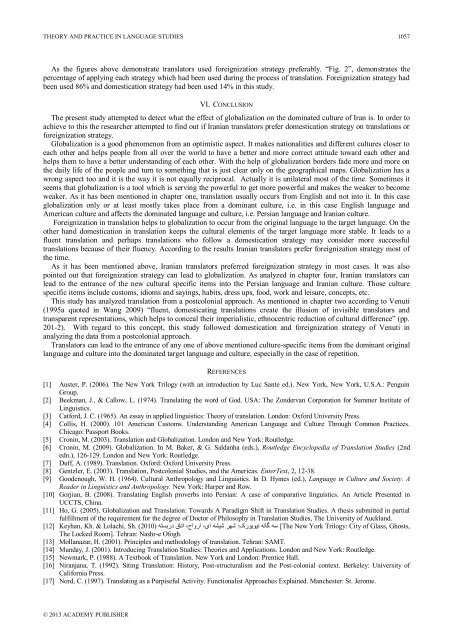Theory and Practice in Language Studies Contents - Academy ...
Theory and Practice in Language Studies Contents - Academy ...
Theory and Practice in Language Studies Contents - Academy ...
You also want an ePaper? Increase the reach of your titles
YUMPU automatically turns print PDFs into web optimized ePapers that Google loves.
THEORY AND PRACTICE IN LANGUAGE STUDIES 1057As the figures above demonstrate translators used foreignization strategy preferably. “Fig. 2”, demonstrates thepercentage of apply<strong>in</strong>g each strategy which had been used dur<strong>in</strong>g the process of translation. Foreignization strategy hadbeen used 86% <strong>and</strong> domestication strategy had been used 14% <strong>in</strong> this study.VI. CONCLUSIONThe present study attempted to detect what the effect of globalization on the dom<strong>in</strong>ated culture of Iran is. In order toachieve to this the researcher attempted to f<strong>in</strong>d out if Iranian translators prefer domestication strategy on translations orforeignization strategy.Globalization is a good phenomenon from an optimistic aspect. It makes nationalities <strong>and</strong> different cultures closer toeach other <strong>and</strong> helps people from all over the world to have a better <strong>and</strong> more correct attitude toward each other <strong>and</strong>helps them to have a better underst<strong>and</strong><strong>in</strong>g of each other. With the help of globalization borders fade more <strong>and</strong> more onthe daily life of the people <strong>and</strong> turn to someth<strong>in</strong>g that is just clear only on the geographical maps. Globalization has awrong aspect too <strong>and</strong> it is the way it is not equally reciprocal. Actually it is unilateral most of the time. Sometimes itseems that globalization is a tool which is serv<strong>in</strong>g the powerful to get more powerful <strong>and</strong> makes the weaker to becomeweaker. As it has been mentioned <strong>in</strong> chapter one, translation usually occurs from English <strong>and</strong> not <strong>in</strong>to it. In this caseglobalization only or at least mostly takes place from a dom<strong>in</strong>ant culture, i.e. <strong>in</strong> this case English language <strong>and</strong>American culture <strong>and</strong> affects the dom<strong>in</strong>ated language <strong>and</strong> culture, i.e. Persian language <strong>and</strong> Iranian culture.Foreignization <strong>in</strong> translation helps to globalization to occur from the orig<strong>in</strong>al language to the target language. On theother h<strong>and</strong> domestication <strong>in</strong> translation keeps the cultural elements of the target language more stable. It leads to afluent translation <strong>and</strong> perhaps translations who follow a domestication strategy may consider more successfultranslations because of their fluency. Accord<strong>in</strong>g to the results Iranian translators prefer foreignization strategy most ofthe time.As it has been mentioned above, Iranian translators preferred foreignization strategy <strong>in</strong> most cases. It was alsopo<strong>in</strong>ted out that foreignization strategy can lead to globalization. As analyzed <strong>in</strong> chapter four, Iranian translators canlead to the entrance of the new cultural specific items <strong>in</strong>to the Persian language <strong>and</strong> Iranian culture. Those culturespecific items <strong>in</strong>clude customs, idioms <strong>and</strong> say<strong>in</strong>gs, habits, dress ups, food, work <strong>and</strong> leisure, concepts, etc.This study has analyzed translation from a postcolonial approach. As mentioned <strong>in</strong> chapter two accord<strong>in</strong>g to Venuti(1995a quoted <strong>in</strong> Wang 2009) “fluent, domesticat<strong>in</strong>g translations create the illusion of <strong>in</strong>visible translators <strong>and</strong>transparent representations, which helps to conceal their imperialistic, ethnocentric reduction of cultural difference” (pp.201-2). With regard to this concept, this study followed domestication <strong>and</strong> foreignization strategy of Venuti <strong>in</strong>analyz<strong>in</strong>g the data from a postcolonial approach.Translators can lead to the entrance of any one of above mentioned culture-specific items from the dom<strong>in</strong>ant orig<strong>in</strong>allanguage <strong>and</strong> culture <strong>in</strong>to the dom<strong>in</strong>ated target language <strong>and</strong> culture, especially <strong>in</strong> the case of repetition.REFERENCES[1] Auster, P. (2006). The New York Trilogy (with an <strong>in</strong>troduction by Luc Sante ed.). New York, New York, U.S.A.: Pengu<strong>in</strong>Group.[2] Beekman, J., & Callow, L. (1974). Translat<strong>in</strong>g the word of God. USA: The Zondervan Corporation for Summer Institute ofL<strong>in</strong>guistics.[3] Catford, J. C. (1965). An essay <strong>in</strong> applied l<strong>in</strong>guistics: <strong>Theory</strong> of translation. London: Oxford University Press.[4] Collis, H. (2000). 101 American Customs. Underst<strong>and</strong><strong>in</strong>g American <strong>Language</strong> <strong>and</strong> Culture Through Common <strong>Practice</strong>s.Chicago: Passport Books.[5] Cron<strong>in</strong>, M. (2003). Translation <strong>and</strong> Globalization. London <strong>and</strong> New York: Routledge.[6] Cron<strong>in</strong>, M. (2009). Globalization. In M. Baker, & G. Saldanha (eds.), Routledge Encyclopedia of Translation <strong>Studies</strong> (2ndedn.), 126-129. London <strong>and</strong> New York: Routledge.[7] Duff, A. (1989). Translation. Oxford: Oxford University Press.[8] Gentzler, E. (2003). Translation, Postcolonial <strong>Studies</strong>, <strong>and</strong> the Americas. EnterText, 2, 12-38.[9] Goodenough, W. H. (1964). Cultural Anthropology <strong>and</strong> L<strong>in</strong>guistics. In D. Hymes (ed.), <strong>Language</strong> <strong>in</strong> Culture <strong>and</strong> Society. AReader <strong>in</strong> L<strong>in</strong>guistics <strong>and</strong> Anthropology. New York: Harper <strong>and</strong> Row.[10] Gorjian, B. (2008). Translat<strong>in</strong>g English proverbs <strong>in</strong>to Persian: A case of comparative l<strong>in</strong>guistics. An Article Presented <strong>in</strong>UCCTS, Ch<strong>in</strong>a.[11] Ho, G. (2005). Globalization <strong>and</strong> Translation: Towards A Paradigm Shift <strong>in</strong> Translation <strong>Studies</strong>. A thesis submitted <strong>in</strong> partialfulfillment of the requirement for the degree of Doctor of Philosophy <strong>in</strong> Translation <strong>Studies</strong>, The University of Auckl<strong>and</strong>.[12] Keyhan, Kh. & Lolachi, Sh. (2010) سً گاوً ویُیُرک : ضٍز ضیطً ای، ارَاح، اتاق درتستً [The New York Trilogy: City of Glass, Ghosts,The Locked Room]. Tehran: Nashr-e Ofogh.[13] Mollanazar, H. (2001). Pr<strong>in</strong>ciples <strong>and</strong> methodology of translation. Tehran: SAMT.[14] Munday, J. (2001). Introduc<strong>in</strong>g Translation <strong>Studies</strong>: Theories <strong>and</strong> Applications. London <strong>and</strong> New York: Routledge.[15] Newmark, P. (1988). A Textbook of Translation. New York <strong>and</strong> London: Prentice Hall.[16] Niranjana, T. (1992). Sit<strong>in</strong>g Translation: History, Post-structuralism <strong>and</strong> the Post-colonial context. Berkeley: University ofCalifornia Press.[17] Nord, C. (1997). Translat<strong>in</strong>g as a Purpiseful Activity. Functionalist Approaches Expla<strong>in</strong>ed. Manchester: St. Jerome.© 2013 ACADEMY PUBLISHER
















